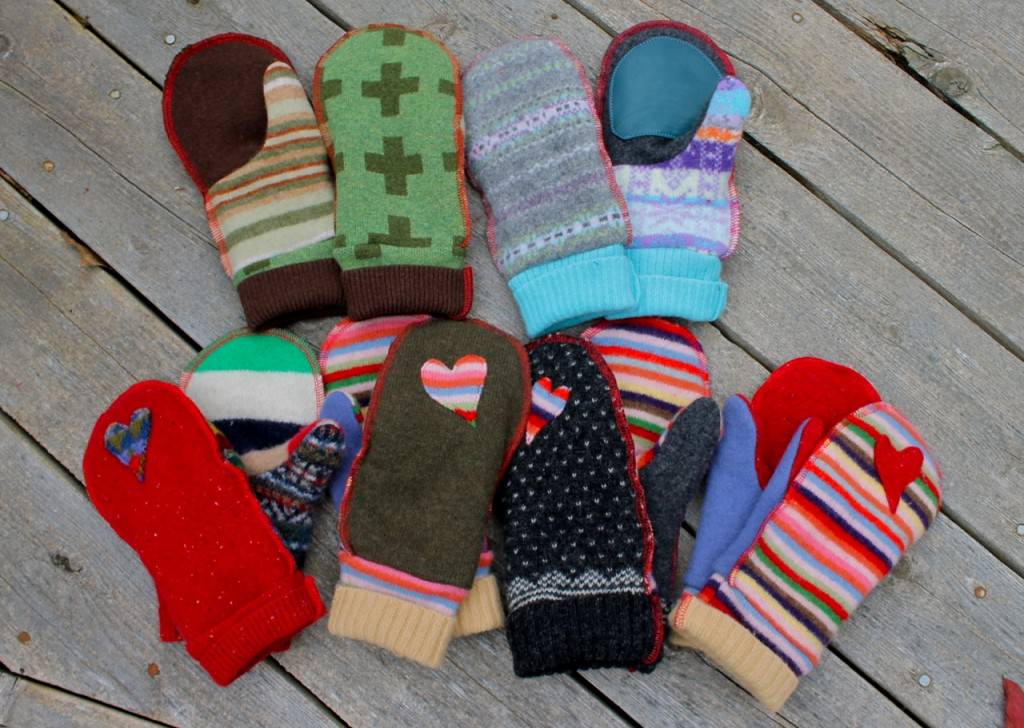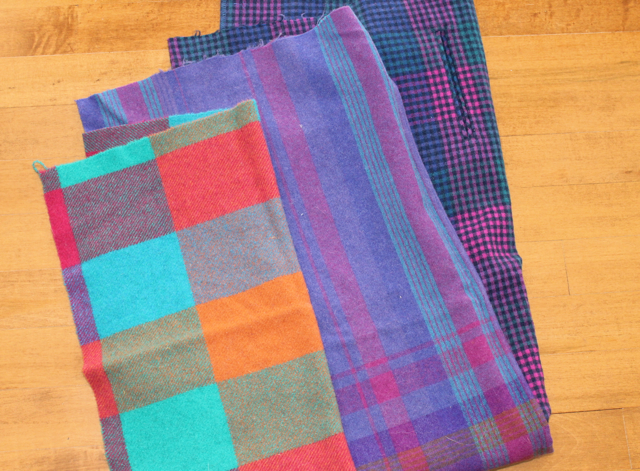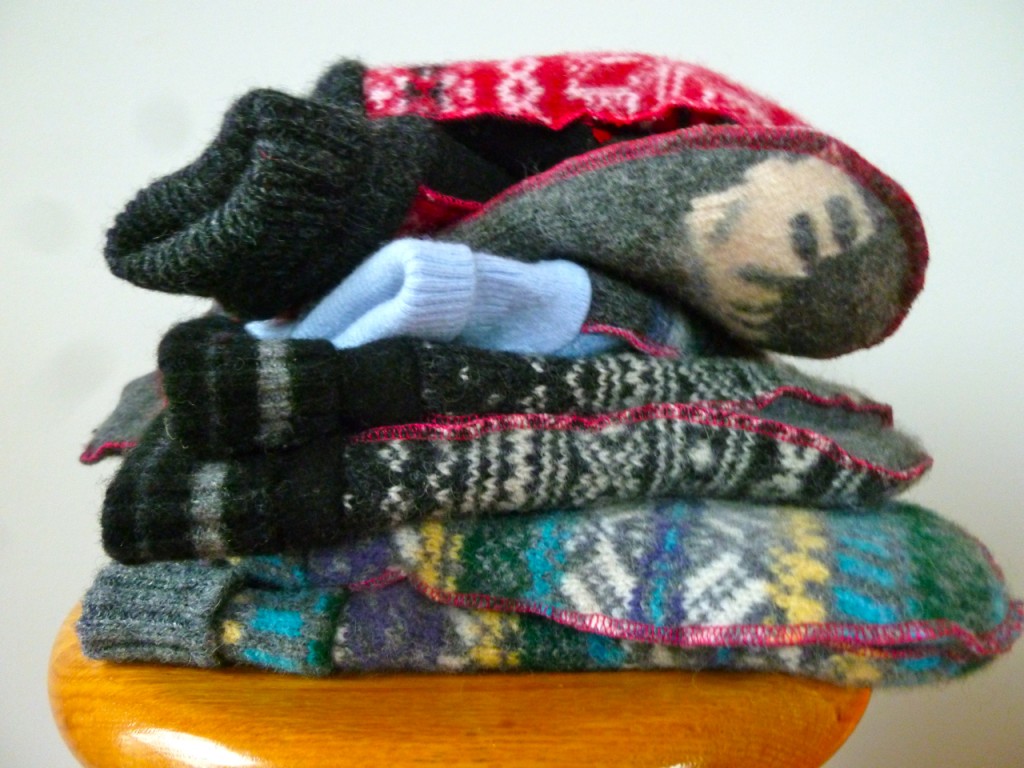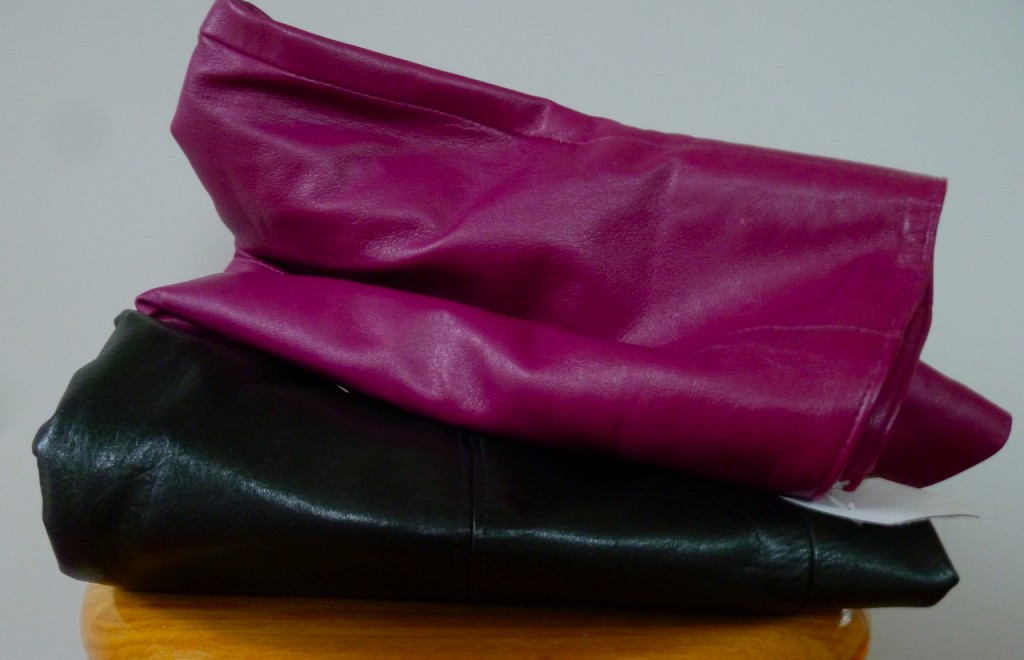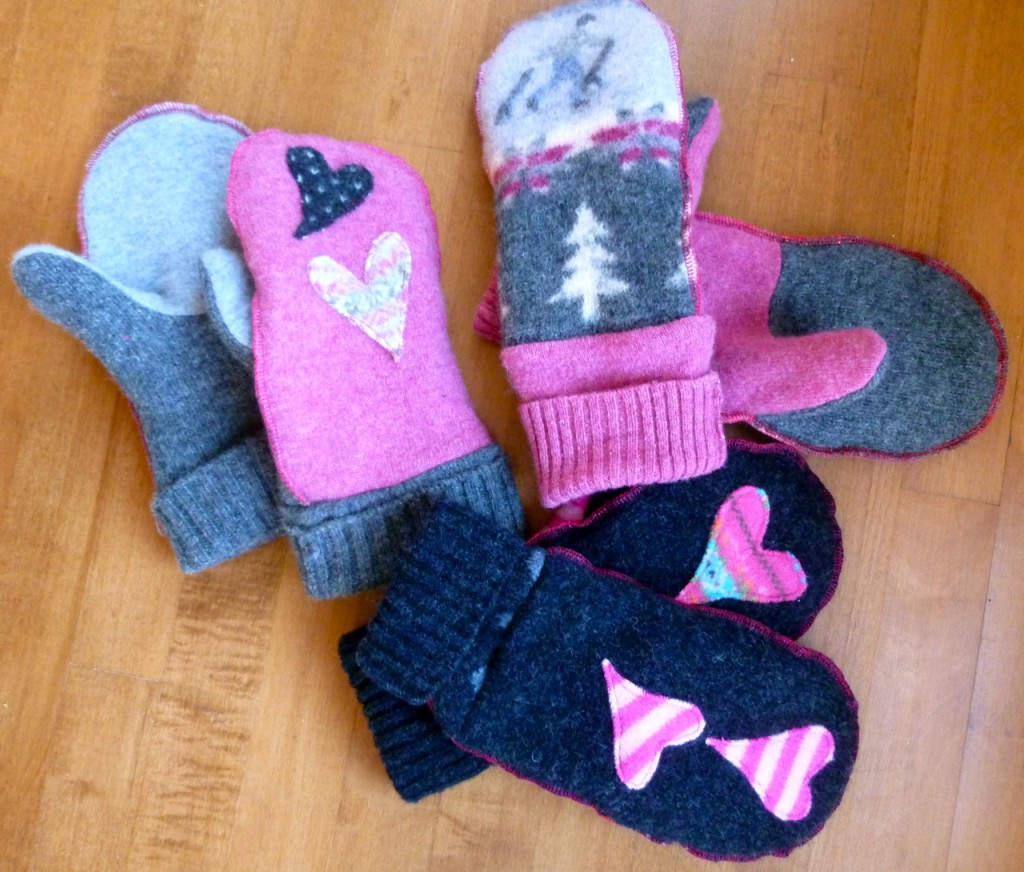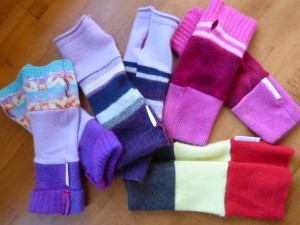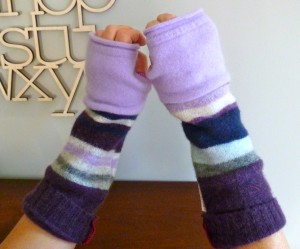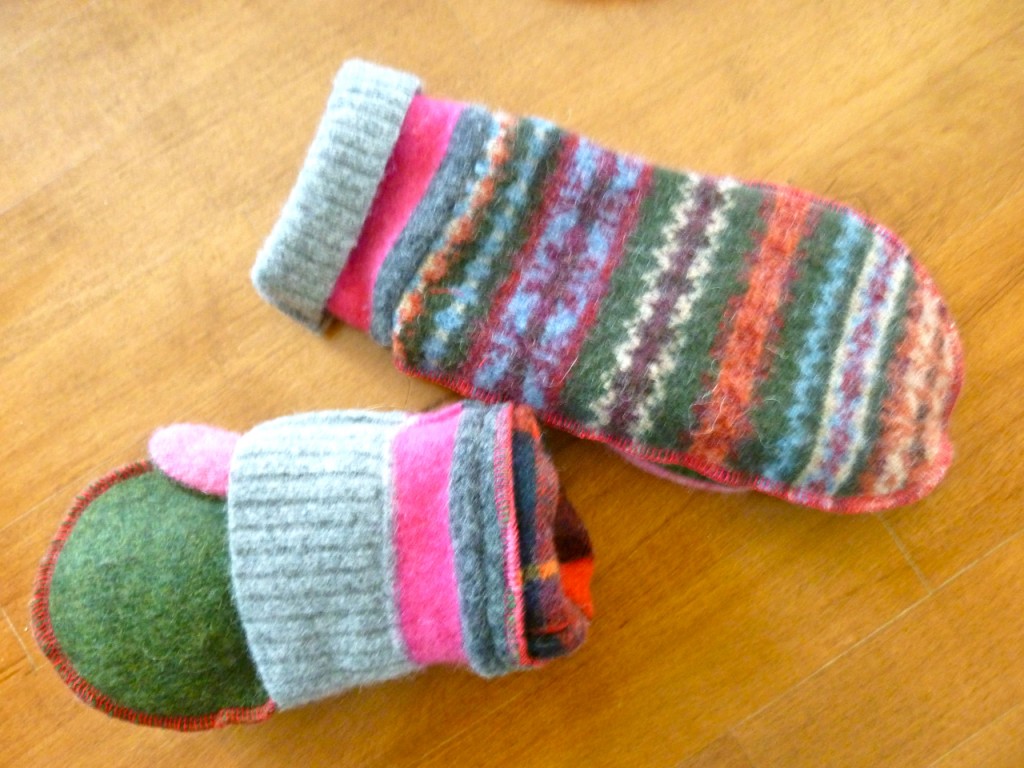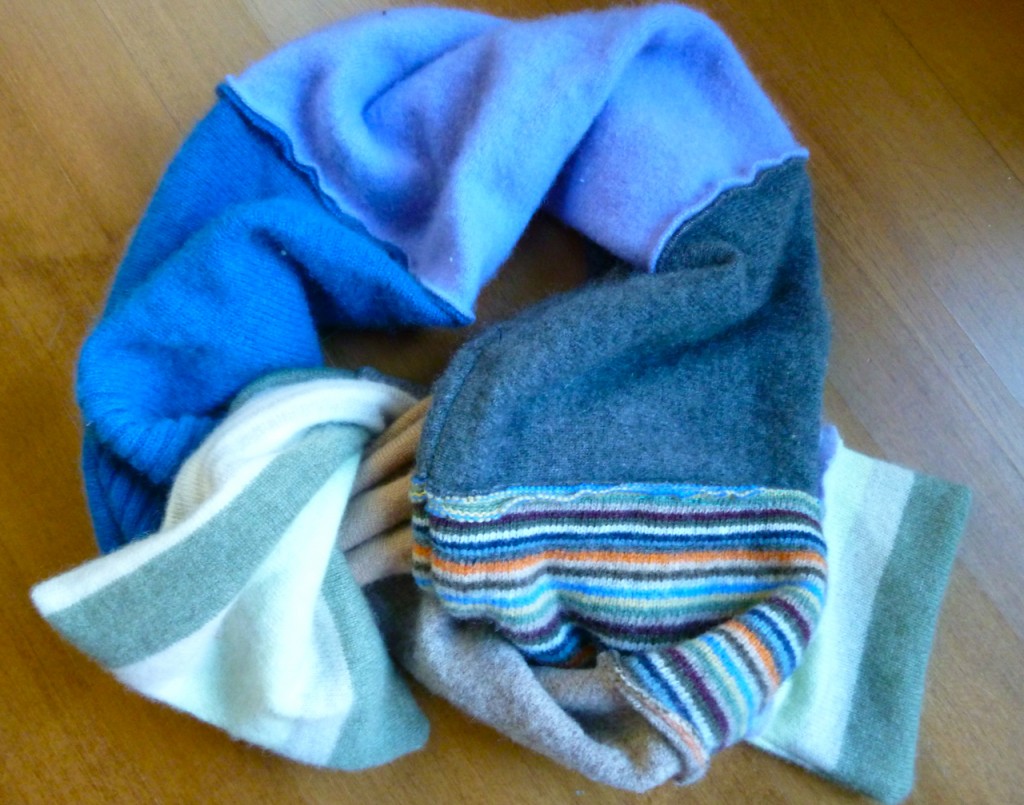Perfect for sketching or texting, these finger-free gloves keep you warm but don’t keep you from doing what you need to. They are shaped to fit snugly and have a cuff which rolls up for extra warmth. Made from a great sweater, they have a wonderful colour to cheer you on a cold blustery morning. 
recycled wool
below zero
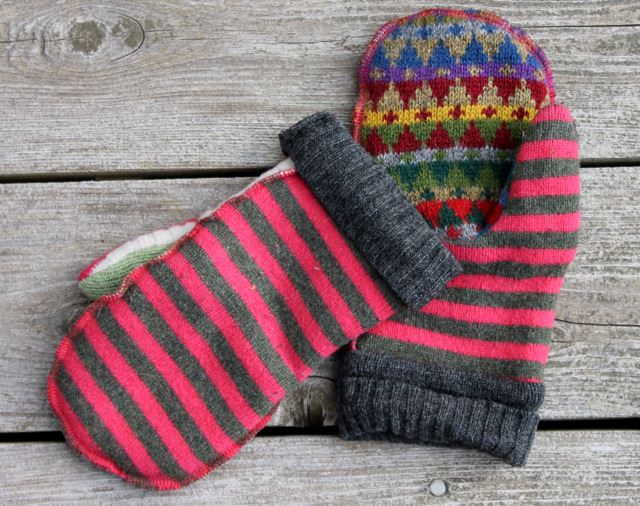 I have been cutting out mitten pieces for the last little while, but since it was -2 this morning, I thought it was time to start assembling. These mittens are made from recycled wool sweaters and lined with recycled wool or cashmere scarves so they are doubly cozy. On the left is my own pair which I was wearing this morning. This is their third winter.
I have been cutting out mitten pieces for the last little while, but since it was -2 this morning, I thought it was time to start assembling. These mittens are made from recycled wool sweaters and lined with recycled wool or cashmere scarves so they are doubly cozy. On the left is my own pair which I was wearing this morning. This is their third winter.
The sweaters have great graphic designs and I am experimenting with adding leather and sheepskin on some of them. Below is the first sample with leather palms. And below that is a pair where the original sweater pattern really works. The fun of working with recycled materials is the hunt–you never know what you will find. And when I find something great, I use every square inch of it. Yesterday I came upon a lime green boiled wool sweater, the perfect weight and colour for finger-free gloves. They are in the works now.
slow clothing–it’s time
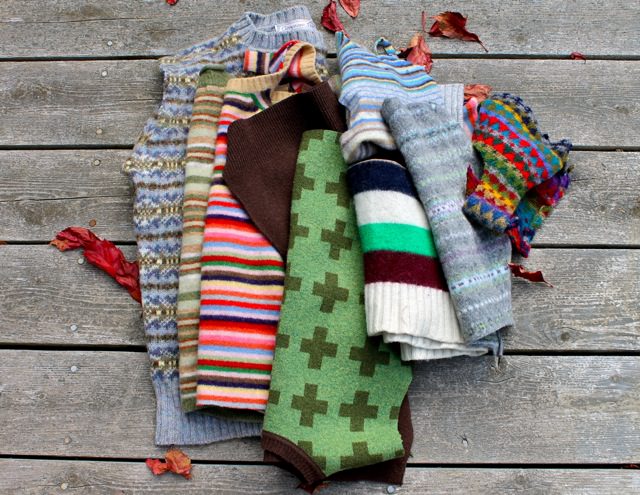 ” As … major international retailers grapple with the moral and technical challenges of producing fast fashion in Bangladesh, a movement to change the way people think about what they wear seems to be inching mainstream. Call it Slow Clothing.” (Toronto Star, July 12, 2013).
” As … major international retailers grapple with the moral and technical challenges of producing fast fashion in Bangladesh, a movement to change the way people think about what they wear seems to be inching mainstream. Call it Slow Clothing.” (Toronto Star, July 12, 2013).
I have been making mittens from recycled sweaters and woollen scarves for some time and it is a slow process, but one I enjoy. Each pair of mittens is unique. I love combining the colours and patterns — and the quality of the wool you can find in thrift stores, often from Scottish or Italian mills, is much superior to what is available as fast fashion. Much. Combining these pieces to make something beautiful the second time around is, for me, a kind of homage to great design and workmanship. Sporting such apparel makes a fashion statement for sure, but it also makes an ethical one. And it is time.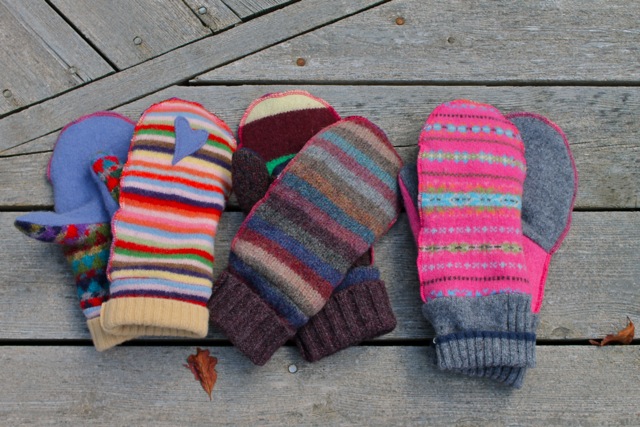
and the start of a new year
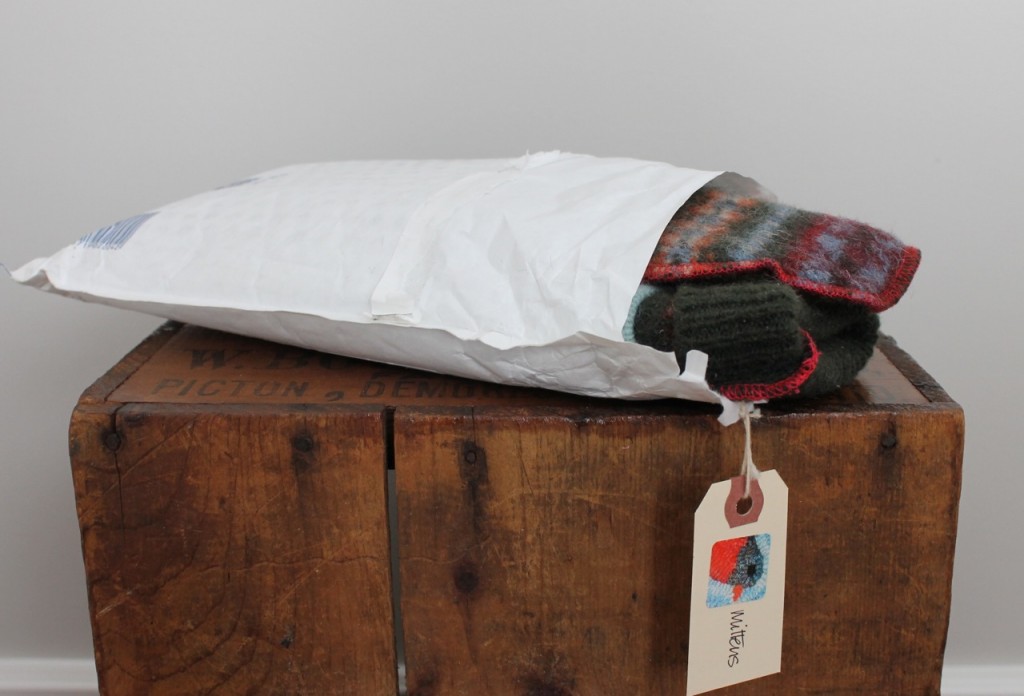 I am working on a few things in the studio. I have exactly two weeks before I leave for a month in rural Kenya. So the start of 2013 sees me finishing things up. A bag or two. An application. And all the details which I need to settle before my trip. Here is the very last pair of 2012 mittens on their way to a new owner. One of the things you will see in the spring of 2013 is a new Birdbrain shop option. You will be able to look at several views of a product, get all the details about it, press purchase and use paypal. This should make things much smoother for you and me.
I am working on a few things in the studio. I have exactly two weeks before I leave for a month in rural Kenya. So the start of 2013 sees me finishing things up. A bag or two. An application. And all the details which I need to settle before my trip. Here is the very last pair of 2012 mittens on their way to a new owner. One of the things you will see in the spring of 2013 is a new Birdbrain shop option. You will be able to look at several views of a product, get all the details about it, press purchase and use paypal. This should make things much smoother for you and me.
I hope that 2013 is starting off well for all of you. This is my second fresh new year on the blog and I want it to be a year of change and learning and contribution. Bob Ramsay has an interesting take on making each day count in today’s Toronto Star. Worth thinking about. Or as Mary Oliver asks,
Tell me, what else should I have done?
Doesn’t everything die at last, and too soon?
Tell me, what is it you plan to do
with your one wild and precious life?
cold weather wear…
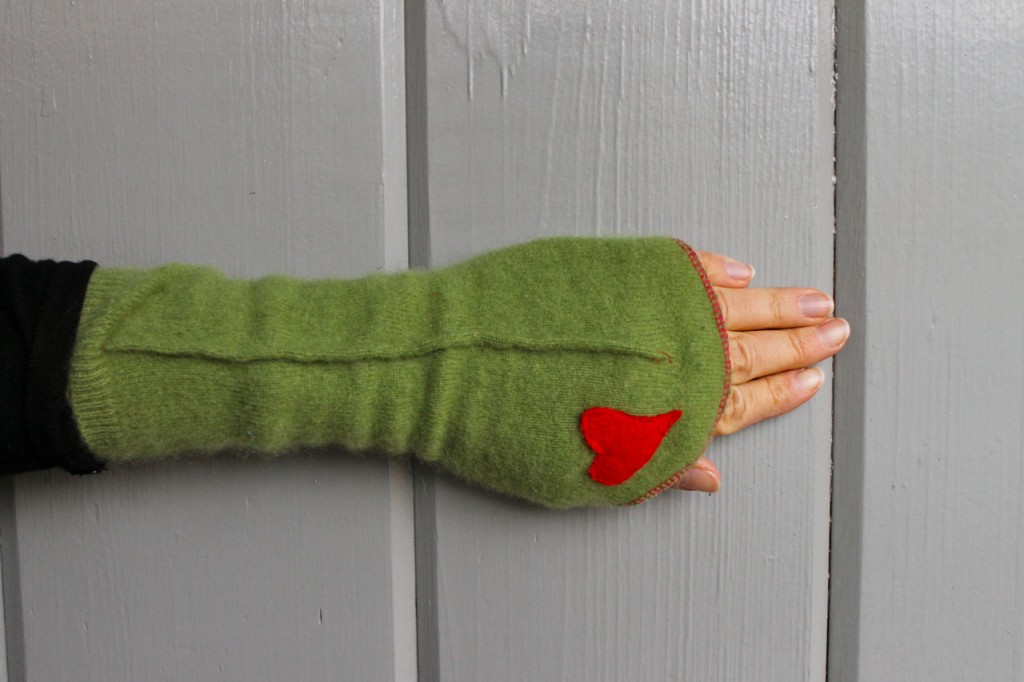 I have been making some Finger Free Gloves out of recycled cashmere and boiled wool. They are great for sketching, texting or photography — surprisingly cozy. I wore mine every day in chilly Paris. And Carissa tells me it is so cold at work that she needs a pair there!
I have been making some Finger Free Gloves out of recycled cashmere and boiled wool. They are great for sketching, texting or photography — surprisingly cozy. I wore mine every day in chilly Paris. And Carissa tells me it is so cold at work that she needs a pair there! 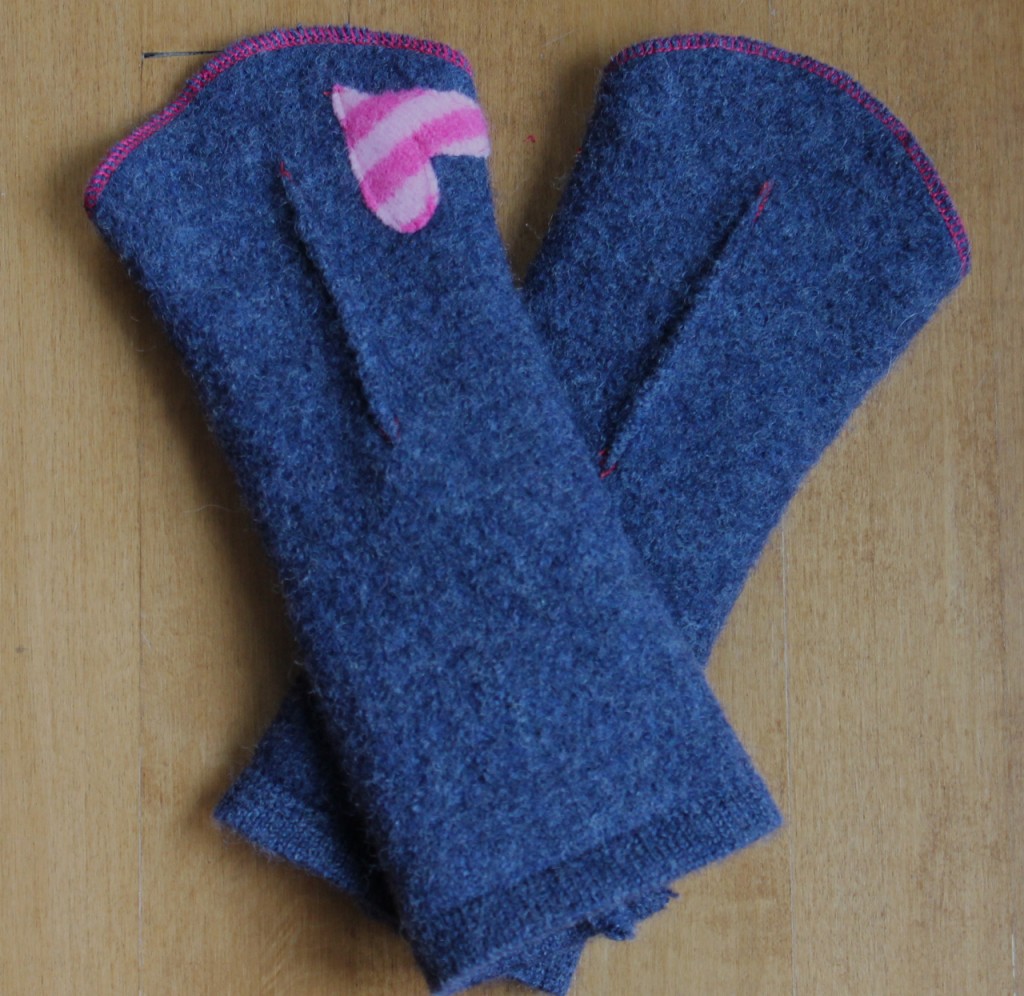
I am also back at mitten-making. These take a lot of time as I line them with recycled wool, mostly soft cashmere scarves — but I do enjoy making them, combining the colours and textures. Recycled sweaters are such a source of fabulous colour and design.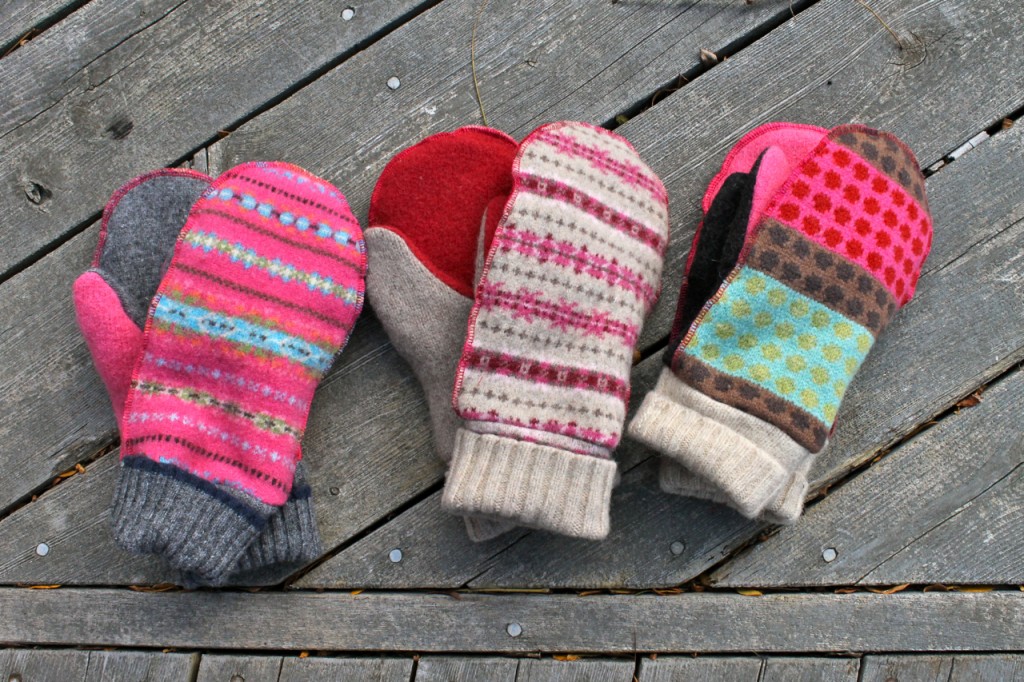
pendleton skirts
I love vintage 100% woollen Pendleton skirts. I find them in thrift shops and in the big bin at the back of the Dorr Mill store. Here are three particularly nice ones I have on hand, washed and ready to go. I use them for the backs of pillows and chair pads and I also dye them for hooking. I was surprised to find an Etsy site that specializes in these great skirts–right now has 418 of them! Now I must say, I prefer the hunt through the thrift store bins and the thrift store prices too–but there must be far greater interest in these vintage beauties than I know. Are people wearing them again?
some endings and a beginning
I am winding down and ready for a break. Below is the last pile of mittens for 2011. Included in the pile is my first pair of men’s mittens (hidden in the back–dark, masculine tones, I assure you!) These are a special pair, lined with cashmere. Making these mittens is addictive–such fun to put the colours and patterns together. But ENOUGH!
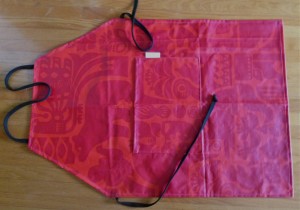 And this is my final apron and my last piece of Marimekko fabric. I found some a couple of years ago in a store on Queen St. West in Toronto and of course, did not buy enough. And now the store is no longer there. Like Vera’s work, I have loved Marimekko since the 60’s when it was very available. This photo does not do justice to the wonderful designs on this coated fabric. If you click on Marimekko, you can view their fall fashion show–the fabrics are so inspiring. If you know where I can find some of this fabulous fabric, please let me know.
And this is my final apron and my last piece of Marimekko fabric. I found some a couple of years ago in a store on Queen St. West in Toronto and of course, did not buy enough. And now the store is no longer there. Like Vera’s work, I have loved Marimekko since the 60’s when it was very available. This photo does not do justice to the wonderful designs on this coated fabric. If you click on Marimekko, you can view their fall fashion show–the fabrics are so inspiring. If you know where I can find some of this fabulous fabric, please let me know.
But on to new things. Below are two skirts I found in a thrift shop this week. They are both great quality leather, but the magenta is an amazing colour and not readily available in thrift stores. So…I am already planning a new bag. My inspiration is visiting on Christmas day, so we may have time to draft up a new design!
warm woollies
Yesterday we had our family sale in Kingston–thank you to all you attended. Next week it is here in Belleville. So I’ve been making mittens and experimenting with fingerless gloves. With the latter, it is all about length and I think my small ‘focus group’ — thank you Miranda — has convinced me that shorter is better. I’ll be making more this week. They are cozy, mostly made of cashmere, leave fingers free, and add a welcome shot of colour on these drab November days. Colour always helps and a few hearts sprinkled on mittens can’t hurt either!
the lining is the best part
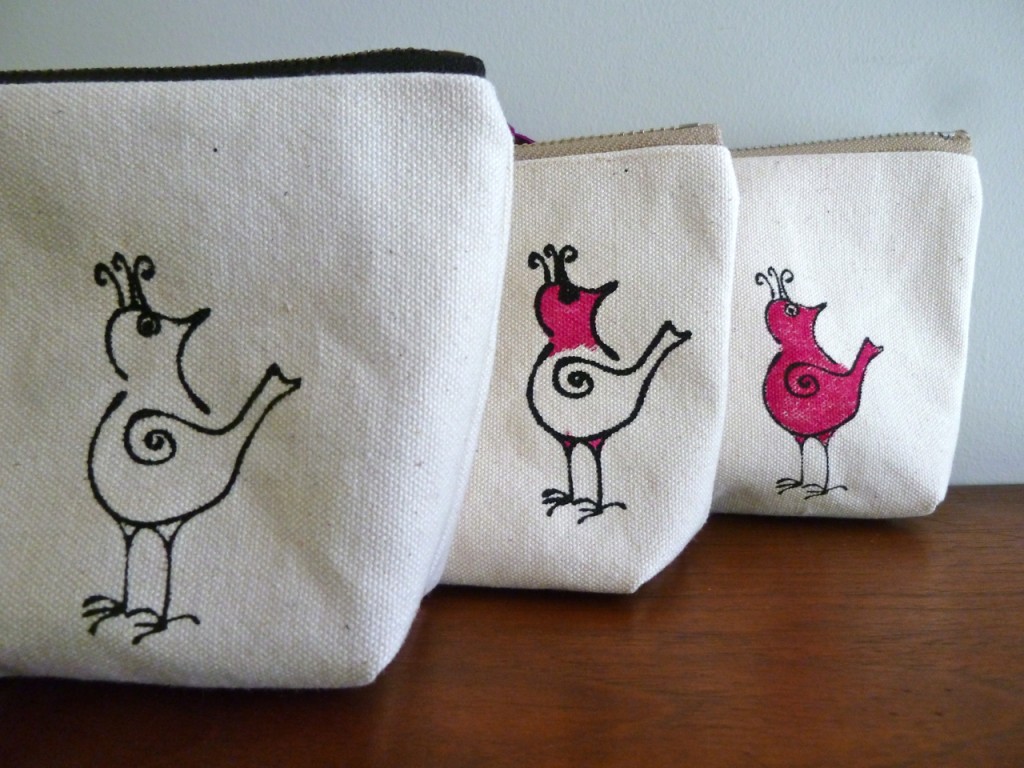 I made a few new bird with attitude pouches to take to the Gallery 121 xmas show along with some new mittens. I was thinking about why these little canvas pouches are so much fun to make. I like screening and then painting that cheeky bird–yes–but the most fun is choosing a lining, and I like to make each one different. I want the owner to have a smile when they open the pouch. The same is true of my leather bags–I always try to have a surprise inside–usually a bird peaking out at you with an impertinent look.
I made a few new bird with attitude pouches to take to the Gallery 121 xmas show along with some new mittens. I was thinking about why these little canvas pouches are so much fun to make. I like screening and then painting that cheeky bird–yes–but the most fun is choosing a lining, and I like to make each one different. I want the owner to have a smile when they open the pouch. The same is true of my leather bags–I always try to have a surprise inside–usually a bird peaking out at you with an impertinent look.
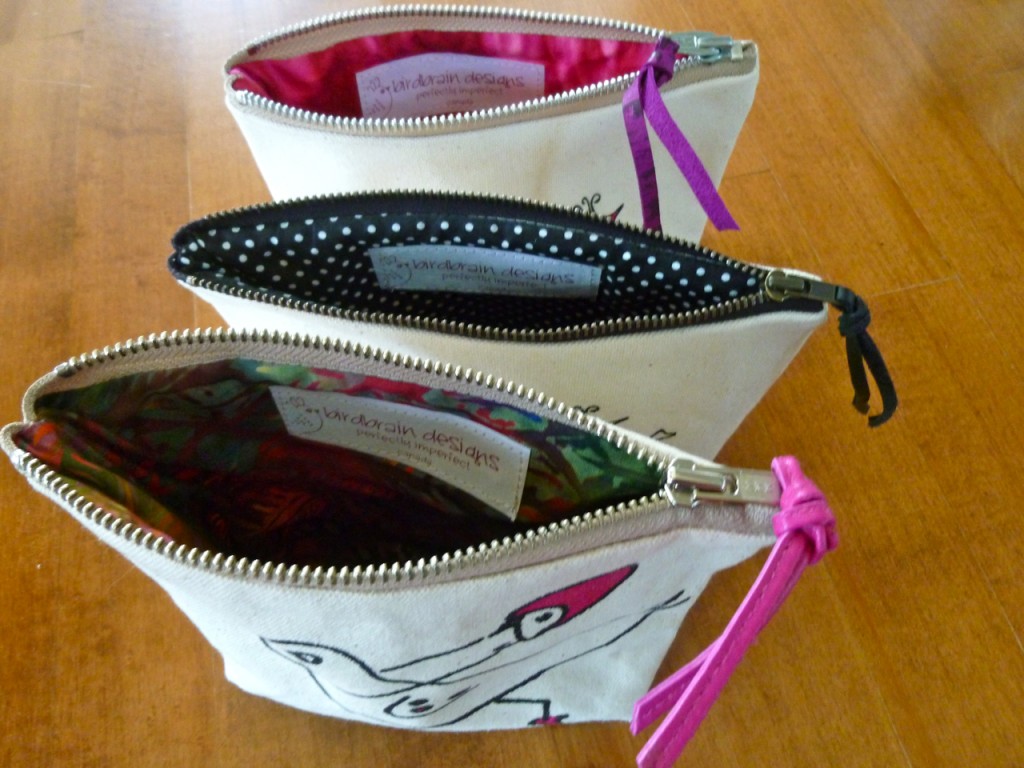 Linings are also key in my mittens. The outsides are made from assorted recycled sweaters which have been fulled–washed in hot water, rinsed in cold and popped in the dryer. This helps the fibres snuggle in beside one another to give the wearer added warmth. But the linings of these mittens are recycled scarves, always 100% wool and sometimes cashmere. The lining you see peeking out here is a scarf my dear friend June found for me in a thrift shop, a Ralph Lauren, complete with monogram, 100% wool made in Scotland. The lining is the best part!
Linings are also key in my mittens. The outsides are made from assorted recycled sweaters which have been fulled–washed in hot water, rinsed in cold and popped in the dryer. This helps the fibres snuggle in beside one another to give the wearer added warmth. But the linings of these mittens are recycled scarves, always 100% wool and sometimes cashmere. The lining you see peeking out here is a scarf my dear friend June found for me in a thrift shop, a Ralph Lauren, complete with monogram, 100% wool made in Scotland. The lining is the best part!
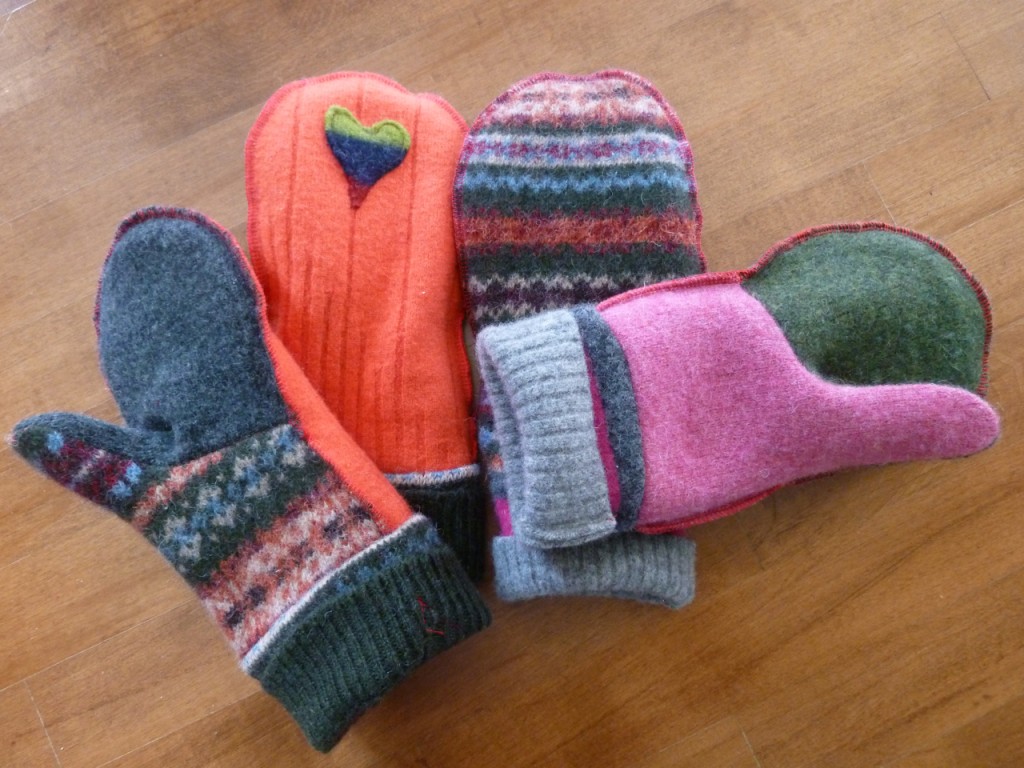
murmurations
Years ago I read The Mountain and The Valley by Ernest Buckler. One of the images that has stayed with me is the one of the grandmother making rugs from carefully saved family clothing. As she hooks each piece into the rug, her mind is inundated by the image of the child or adult wearing it and the emotions connected to the scene.
I’ve been making scarves lately from the bag of cashmere sweaters I have been saving. In my experience, cashmere is not often found in thrift shops–wearers find other uses for this beautiful, warm fibre when it is no longer presentable, either lining the cat’s bed with it or wearing it to bed themselves. So my cashmere fragments are from my own cast-offs and those of generous friends. As I pieced the scarf together this morning, the visceral images brought back by this bag of coloured wool were breathtaking. There was Anne in her beautiful striped pullover and Janet in her orange cardigan. J.A. Wainright, in an essay on Buckler’s Nova Scotia novel, summed up the grandmother’s activity:
When she is alone in this room and “without speech,” Martha is happy because “her tasks are like a kind of conversation” (p. 24); she does not need to talk to others in order to “come alive,” and her mind obviously has its own “shining population”.
So here is to all rug hookers and ‘repurposers’ of woollen garments. Enjoy your conversation with that shining population.

